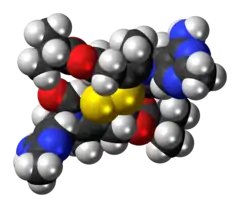Sulbutiamine
Sulbutiamine (brand names Arcalion, Enerion) is a synthetic derivative of thiamine (vitamin B1). In France, it is used to treat symptoms of weakness or fatigue. It is also sold as a dietary supplement. Sulbutiamine was discovered in Japan as part of an effort to develop useful thiamine derivatives.
 | |
 | |
| Clinical data | |
|---|---|
| Trade names | Arcalion, Enerion |
| AHFS/Drugs.com | International Drug Names |
| Routes of administration | Oral |
| ATC code | |
| Pharmacokinetic data | |
| Elimination half-life | 5 hours |
| Excretion | Renal |
| Identifiers | |
IUPAC name
| |
| CAS Number | |
| PubChem CID | |
| ChemSpider | |
| UNII | |
| KEGG | |
| CompTox Dashboard (EPA) | |
| ECHA InfoCard | 100.019.944 |
| Chemical and physical data | |
| Formula | C32H46N8O6S2 |
| Molar mass | 702.89 g·mol−1 |
| 3D model (JSmol) | |
SMILES
| |
InChI
| |
| | |
Medical use
Sulbutiamine is used to treat asthenia (symptoms of fatigue or weakness),[1] though is not clear if it is effective in alleviating tiredness.[2] It is also used to treat thiamine deficiency and poor concentration. Being a potent cholinergic anxiolytic, Sulbutiamine is a popular nootropic, with users reporting enhanced memory, focus and improved mood and motivation. Endurance athletes may use it to try to enhance their performance.[3]
Adverse effects
Adverse effects in clinical trials have included diarrhea, bladder infections, bronchitis, arthritic pain, back pain, asthma, abdominal pain, insomnia, constipation, gastroenteritis, diffuse pain, sinusitis, headache, kidney pain, vertigo, and sore throat.[4]
History

Efforts to develop thiamine derivatives with better bioavailability than thiamine were conducted in the 1950s, mainly in Japan. These efforts led to the discovery of allicin (diallyl thiosulfinate) in garlic, which became a model for medicinal chemistry efforts to create other thiamine disulfides. The results included sulbutiamine, fursultiamine (thiamine tetrahydrofurfuryl disulfide) and benfothiamine. These compounds are hydrophobic, easily pass from the intestines to the bloodstream, and are reduced to thiamine by cysteine or glutathione.[5]: 302 [6]
It was first marketed in France by Servier in 1973 under the brand name Arcalion. The drug registration went through a validation procedure in France in the 1980s, which found that the use for treatment of fatigue was not supported by data.[2] In January 1989, 100 mg tablet doses were discontinued in favour of 200 mg tablets.[7]
Research
Because thiamine deficiency causes problems with memory and other cognitive functions, thiamine and analogs like sulbutiamine have been studied in clinical trials in the 1980s and 1990s for age-associated cognitive decline.[8]
Sulbutiamine has been explored in clinical trials as a potential treatment for chronic fatigue syndrome.[4] Studies have also been undertaken to assess its impact on reversing age-related changes in the circadian system.[9]
The pharmacology of sulbutiamine has been studied in various mice and rats; as of 2014 it appeared that sulbutiamine might be more effective in raising thiamine phosphate levels in the brain than benfotiamine and fursultiamine, but this has not been fully verified.[5]: 303 University of Oxford studies indicate that it helps prevent apoptotic cell death, caused by trophic factor deprivation, in retinal ganglion cells.[10]
In an uncontrollled clinical trial, sulbutiamine was reported to be effective in reducing fatigue in patients with multiple sclerosis.[11]
See also
- Vitamin B1 analogue
- Pyritinol
References
- "Fiche info - Araclion 200 mg" (in French). Base de données publique des médicaments: ANSM of HAS et UNCAM. Retrieved 28 January 2018.
- Rane W (1997). "High Cost, Low Efficiency Medicines". Economic and Political Weekly. 32 (51): 3251. JSTOR 4406199.
- Kazlauskas R (2010). "Advances in sports drug testing: an overview". Drug Testing and Analysis. 2 (11–12): 523–5. doi:10.1002/dta.251. PMID 21204284.

- Alraek T, Lee MS, Choi TY, Cao H, Liu J (October 2011). "Complementary and alternative medicine for patients with chronic fatigue syndrome: a systematic review". BMC Complementary and Alternative Medicine. 11: 87. doi:10.1186/1472-6882-11-87. PMC 3201900. PMID 21982120.
- Bettendorff L (2014). "Chapter 7 - Thiamine". In Zempleni J, Suttie JW, Gregory JF, Stover PJ (eds.). Handbook of vitamins (Fifth ed.). Hoboken: CRC Press. pp. 267–324. ISBN 9781466515574.
- Volvert ML, Seyen S, Piette M, Evrard B, Gangolf M, Plumier JC, Bettendorff L (June 2008). "Benfotiamine, a synthetic S-acyl thiamine derivative, has different mechanisms of action and a different pharmacological profile than lipid-soluble thiamine disulfide derivatives". BMC Pharmacology. 8: 10. doi:10.1186/1471-2210-8-10. PMC 2435522. PMID 18549472.
- "Economic and Political Weekly, Volume 32". Sameeksha Trust. 1997. p. 3251.
- Riedel WJ, Jolles J (April 1996). "Cognition enhancers in age-related cognitive decline" (PDF). Drugs & Aging. 8 (4): 245–74. doi:10.2165/00002512-199608040-00003. PMID 8920174. S2CID 22677895.
- "Animal Behavior Abstracts, Volume 23". Cambridge Scientific Extracts. 1995. p. 139.
- Issues in Neuroscience Research and Application: 2011 Edition. Scholarly Editions. 2011. p. 529. ISBN 9781464963605.
- Sevim S, Kaleağası H, Taşdelen B (August 2017). "Sulbutiamine shows promising results in reducing fatigue in patients with multiple sclerosis". Multiple Sclerosis and Related Disorders. 16: 40–43. doi:10.1016/j.msard.2017.05.010. PMID 28755683.